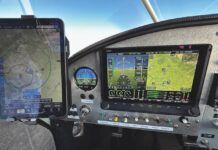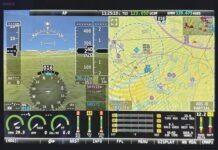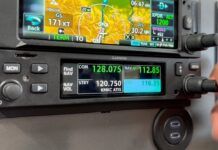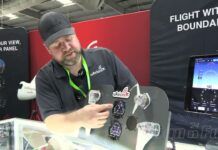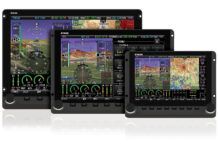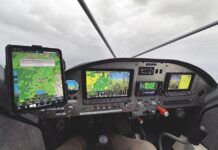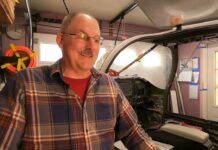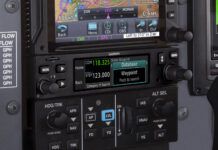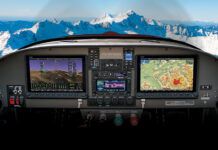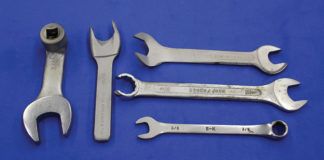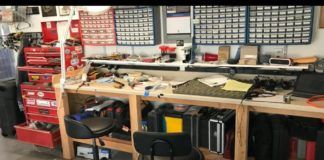So far in this series, we’ve talked about GPSes, nav/coms, EFISes and many other components for your homebuilt. What we have not yet discussed is one of the final steps in getting them working. Most pieces of avionics equipment either send or receive some sort of radio-frequency (RF) signal. That means you’ll be required to install some sort of antenna for each specific unit that requires one, and its here that we see well-meaning builders and shops (who really should know better) make some pretty rookie mistakes that compromise the quality and utility of the installation.
Antennas aren’t elegant, rarely pretty (unless you’re an RF engineer), and when many of us builders are trying to eke out every last bit of speed from our planes we think of the added carbuncles as wasted knots! Like me, you may not relish the thought of adding seemingly unnecessary protuberances to your plane, but to ensure that your new and expensive radios and such work to their best ability, we cant avoid using antennas to do the job.
Practice, Not Theory
We decided not to get into the complex electrical bits and bytes-or, for that matter, theoretical antenna design. But there are a few things you should understand about the various antennas you’ll be working with. First is size. The lower the radio frequency, the longer its wavelength, so the larger the antenna will be. Antennas require a ground plane, which can be either conductive parts of the airplane-the metal wing or fuselage, for example-or a mirror-image portion of the antenna in a design called a dipole. Generally speaking, antennas for aircraft are of two types, either a quarter-wave element using a secondary ground plane or a half-wave dipole that provides its own ground plane. The dipole antenna is the one typically used under the skin in composite, wood or fabric airplanes, or in select ways in metal aircraft. For the aircraft com frequency band, a half-wave dipole will be about 43 inches long, while a quarter-wave “stick” antenna can be about half that. (In practice, the commercially available external antennas are slightly longer.)
The other frequencies we care about include the marker beacon at 75 MHz, transponder and distance measuring equipment (DME) at around 1000 MHz, and GPS at 1575 MHz for the L1 channel and 1227 for the L2 channel. Of these, only the transponder and DME antennas have to send and receive-the transponder receives on 1030 MHz and transmits on 1090, while the DME uses one of 126 channels between 1025 and 1150 MHz-and the high frequencies in use permit small (less than 3 inch) stub antennas to work well.
You can read up on antenna design and theory all you want, but for aircraft half the battle is finding a suitable position on the airframe. Like real estate, antenna performance and capability (read value and usability) are as much a function of location as anything else. When addressing location it brings us to perhaps one of the most discussed issues with antennas: internal versus external antennas. Unfortunately, like almost everything else in aviation there is no simple, works-every-time answer. A number of variables must be considered when looking at whether you can hide an antenna. First, when we talk about internal or external antennas, we usually are discussing completely
different types of antennas. Typically external antennas are the standard sticks hanging out in the air any number of places on the plane. Internal antennas are normally of a construction that is physically unlike external antennas.
Internal antennas are most commonly purchased from a company that specializes in these products. The two most popular manufacturers are AAE (Advanced Aircraft Electronics) and Sportcraft (also known by the inventor, Bob Archer). The AAE antennas are available in several configurations and are meant primarily to be installed in composite airframes. One advantage of the AAE antennas over the do-it-yourself versions well talk about later is that they come pre-terminated with female BNC connectors, which is easier for builders who fear the soldering iron. Many builders of composite aircraft have installed these antennas with success for various avionics components, but they are mainly used for nav and com. AAEs com antennas are a long thin strip (approximately 1 inch x 43 inches), manufactured with a proprietary process. The antennas are typically installed in the aft fuselage area of composite or fabric-covered airframes, and AAE doesn’t recommend its antennas for metal aircraft. That being said, care must be taken with the installation. Our experience has shown that placing them anywhere near a strobe power supply or wiring can result in “strobe squeal” when receiving or transmitting. Likewise, AAE specifically recommends its antennas not be installed close to any metal structure.
Sportcraft antennas by Bob Archer are significantly different from the AAE antennas in that they are made of aluminum and are designed specifically for installation in certain areas of an airframe (mainly a wingtip or tail cap). The Sportcraft antennas are typically installed in a wingtip for either nav or com radios. Sportcraft also manufactures a wingtip marker beacon antenna. The Sportcraft wingtip antennas are designed to be mounted either vertically for com radios or horizontally for nav radios. (The transmitting signal for VHF nav is horizontally polarized, while ground transceivers for the com band are vertically oriented.)
Herein lies the only difficulty we’ve found with these antennas. Because most wingtips are rather shallow in vertical dimension, its difficult to install the com antennas with as much vertical polarity as they should have. Our experience has shown that in aircraft like RVs, the com wingtip antenna does work, but it is greatly degraded in performance compared to externally mounted com antennas. Experience with nav antennas mounted horizontally in the wingtips of aircraft such as RVs has shown very good performance characteristics for VOR, LOC and GS (all are received through the same antenna). The marker beacon antennas also show good performance in the wingtip. Overall, we really like the wingtip nav antennas but not the com antennas.
DIY Antennas
In addition to purchasing internal antennas from companies such as those mentioned above, there are various alternatives for making and installing your own antennas. Someone like our own DIY maven Jim Weir is much more qualified than I am to explain the details of doing so, and you can purchase both an antenna kit as well as a detailed explanation of how to build your own copper foil antennas (antenna reference text: RST-8020) from RST Engineering. This reference is definitely worth reading.
Our experience with copper foil antennas has been mixed. Some installations in certain aircraft have worked pretty darned well, but our overall experience with aircraft other than basic composite (read fiberglass only, not carbon fiber) has been that the copper foil antennas for VHF com post poorer results in aircraft such as RVs than external antennas. I have seen copper foil antennas installed on gear legs, windshields, wheelpants, wingtips, and horizontal and vertical stabs, and while most of the locations work a little bit, they rarely approach the performance of external antennas. I make that statement with one exception-marker beacons. Almost anything will work for a marker beacon antenna, even an old coat hanger stuck out in the wingtip (yes, Ive actually seen that done). This is one antenna that should almost universally be installed in a wingtip or somewhere else hidden.
The last type of internal antenna is basically mounting an antenna designed for the outside of the airplane inside or under something. Again, we see mixed results. Many of you have successfully installed a GPS antenna under your cowling forward of the firewall with favorable results. That being said, with the new generation of WAAS GPSes and their associated antennas, this isn’t necessarily the best approach. First, GPS antennas are very low profile and are physically small, so drag penalties just aren’t that bad. Second, most of the WAAS GPSes require a minimum length of coax cable to perform correctly (normally between 7 and 20 feet), so if you mount it within inches of the actual box, you now have to find something to do with all that extra coax, and extra loops of antenna cable wound up near other avionics boxes is never preferred! Our recommendation is to install the GPS (and other satellite antennas) externally as the manufacturer suggests.
Another popular antenna to “hide” is the transponder antenna. Again, it may work OK hidden under the cowl between the exhaust stacks, but an intermittent or “shadowed” transponder signal isn’t something you want when flying IFR. The transponder antenna is another small one that just isn’t that big of a deal, so again we recommend that it be cleanly installed on the bottom of the aircraft as per the manufacturer.
Overall, we like the internal nav antennas, but not many others. Even at that, the internal nav antennas (as well as com) always will have somewhat degraded performance compared to external antennas. This mainly refers to metal and some fabric aircraft, as pure composite aircraft really don’t degrade the performance of internal antennas like the tube fuselage of a Cub or the metal wing of an RV.
The Three Rules of Stein
Whichever way you decide to go, it matters little if the antennas and associated cabling are not done properly. Improper installation of coax cables, termination and connectors can make a perfectly good physical antenna installation completely useless. There are several rules to follow when installing antenna cables and connectors.
Rule Number One: Thou shall not use cheap twist-on or push-on BNC/TNC connectors you bought at your local hobby store or cheap surplus television coax cable. Spend the extra few dollars for good aircraft-quality cable and connectors (crimp or solder) from a reputable source as well as the proper tooling for each connector. Poorly assembled connectors and coaxial cables are responsible for the majority of noisy radio transmissions and receptions. If the manufacturer recommends RG-400/142 coax (which most now specifically require), then that is what you need to use. Its also important to use connectors rated for RG-400/142 cable. They are not universally interchangeable with old RG-58 connectors, as the center conductor for the newer cable is slightly larger. Take the time to install the connectors properly. Even one tiny stray hair of a wire from the shielding touching somewhere its not supposed to can completely ruin the performance of an antenna. Be sure to test your finished coaxial cables with an ohmmeter to ensure the connections are made properly and there are no shorts between the shield and the center conductor. Check your antenna leads without them connected to either the radio or the antenna, as internal characteristics of both can throw off the reading of your multimeter.
Rule Number Two: Thou shall not place unnecessary connections or joints in your antenna leads. Every time you splice a coax cable there is an opportunity to introduce external interference into your antenna line. Multiple connectors can and will change the characteristics of your coax as well. Many of you already know Im not a fan of wingroot connectors for antenna leads. I know the argument: “Itll be easier if I need to remove the wings.” Well, if you have an aircraft with removable wings and have an antenna installed in the wing, this argument makes sense. If you have an RV, Lancair or other similar aircraft and you’re removing the wings after the plane is finished, its likely due to something bad. My point is that even though it may take a few more minutes to install when building the plane, the overall performance of the antenna lead will be inherently better.
Rule Number Three: Thou shall not install any antennas or coax cables on or very near noisy electrical items or wires such as strobes, P-leads, alternator wires, magnetos, fuel pumps or flap motors. Its wise to try and run your antenna leads separate from noisy wires. If you are able to run the coax cables via a completely different route through the airframe, separate from most of the other electrical bundles, then you’ll greatly reduce the chances of having an alternator whine, strobe squeal or landing-gear moan in your avionics.
Likewise, its important to try and keep the physical antennas themselves far away from noisy items. This isn’t always possible, but try your best. Its also important to keep the antennas themselves separated by a certain distance. Most manufacturers recommend 36 to 48 inches of separation for com antennas (check your specific unit).
By following these three rules, you’ll have a much larger likelihood of a nice, quiet avionics installation. Proper coax cable, correct terminations and keeping antennas away from noisy items will help you keep the RFI (radio frequency interference) and EMI (electromagnetic interference) gremlins away. There is no reason to have a noisy airplane if you take the time to install the antennas properly and treat them as a system instead of an individual component, the system being connectors, cabling, termination, routing and physical installation of the antenna.
RFI and EMI, Not Your Friends
Speaking of RFI and EMI, sometimes there are glitches and gremlins that are really hard to fix or find. Despite your best attempts, you might still end up with some weird things happening on your panel. Many times this isn’t the fault of your actual antenna or coax installation, but instead may stem from physical limitations of some components in your panel. Occasionally, radios will just leak a tiny bit of RFI, and certain components are susceptible to this. Its not uncommon to see an LED indicator or analog gauge flicker or jump when your radio is transmitting. This is something we seek to avoid, and while its not easy, there are ways to work on this issue.
First, ensure that all power, ground and signal wires are not routed in, near, around or next to your radio wires and antenna leads. Second, you may need to twist and/or shield the actual power/ground/signal leads as well. Third, you can try wrapping the offending item (instrument or gauge) with something called mu-metal (a fancy tinfoil-type magnetic shielding) and grounding it. Some of our Experimental products are manufactured in plastic cases without good case grounding, which makes them especially sensitive to RFI and EMI. Lastly, you can experiment with ferrite beads/chokes around the power/ground wires of the offending instrument.
If you spend the time, effort and few extra dollars to ensure that your antennas are installed properly, as well as using good components in the installation of the entire system, you’ll be treated to a wonderfully quiet airplane-at least electrically!
If you have specific questions for author Stein Bruch, or have certain projects youd like us to cover, email us at
[email protected] with “About Avionics” in the subject line.

